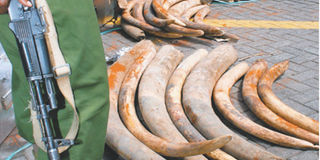Tonnes of ivory seized in Singapore a decade ago to be burnt in Kenya

A KWS officer guards 115 pieces of vory weighing over 1,500kg with a street value of Sh1 billion that was being illegally exported to Nigeria last month.
After almost 10 years of investigations and intense lobbying, seven African countries have agreed that tonnes of contraband ivory seized in Singapore in 2002 be set ablaze in Kenya.
In a high profile ceremony to be attended by members of what is called the Lusaka Agreement, 335 tusks and 41,553 hankos will be set on fire at Tsavo West National Park on July 20.
Hankos are signature stamps, similar to rubber stamps, but made from ivory and popular in Asia. This consignment was destined for Japan.
According to the Lusaka Agreement secretariat’s director Bonaventure Ebayi, who is based in Nairobi, this is part of 6.5 tonnes of ivory seized in Singapore in 2002 and brought to Nairobi in 2004 for investigations.
It was estimated that more than 300 elephants had been killed for the ivory.
Wildlife authorities seized the opportunity to try out a unique law enforcement tool using DNA.
The investigators took samples of the ivory and sent them to the University of Washington in Seattle, US.
One of the investigators, Dr Sam Wasser who is the director of the Center for Conservation Biology at the University of Washington, said they were able to establish that most of the ivory seized in Singapore came from an area in Zambia.
The agreement to destroy the consignment is a rare occurrence among countries as some hold different views on ivory trade.
Tanzania and Zambia are for the opening up of trade in ivory, saying any profits from sales could be ploughed back into elephant conservation.
Kenya on the other hand is opposed to the opening up of the trade, arguing that this could lead to more poaching. The decision to destroy the Singapore hoard was a give and take affair, with no one country emerging a clear winner.
According to Ebayi, not the whole consignment will be destroyed. “Some samples will be taken to Malawi and Zambia for possible prosecution and educational research purposes.” he said.
Sources close to the negotiators indicated that as many as 196 tusks will be repatriated for this purpose but this did not go down very well with organisations such as the International Fund for Animal Welfare, which suspects that such ivory could corruptly end up in the global market.
Wildlife experts are watching how far Kenya is willing to go to prove its sincerity and commitment in destroying its own ivory stockpiles. It is estimated that Kenya has 65 tonnes of ivory from normal elephant deaths and seizures.
There is talk within conservation circles of a possible Cabinet decision on whether these stockpiles will be destroyed together with the contraband tusks.
Any decision either way could elicit criticism, with some conservationists saying burning the ivory would be wasteful.
“There are arguments for using such ivory innovatively to raise funds, such as setting up an ivory museum targeted at tourists, with the money realised being ploughed back into elephant conservation,” says Kenya Wildlife Service (KWS) spokesperson Paul Udoto.
But Udoto is quick to point out that the act of burning ivory as was done in 1989 sends a strong message to the international community.
On July 18, 1989, former President Moi torched 12 tonnes of ivory in a gesture that brought the plight of the African elephant to the world stage, leading to a ban in the trade.
Said Moi at the time: “To stop the poacher, the trader must be also be stopped and to stop the trader, the final buyer must be convinced not to buy ivory ... I appeal to people all over the world to stop buying ivory.”
A decision to destroy Kenya’s stockpiles or no decision at all will be looked at scornfully, especially by Tanzania which holds and estimated 90 tonnes it urgently needs to sell to boost conservation efforts.
Last year, the Tanzanian Minister for Natural Resources and Tourism, Ms Shamsa Mwangunga reacted angrily to a suggestion by Prime Minister Raila Odinga that the neighbouring country destroy its ivory stockpiles.
Mr Odinga was reported by our Tanzania sister newspaper The Citizen during last year’s World Economic Forum on Africa held in Dar es Salaam urging the country to follow Kenya’s example and destroy its stockpiles.
But in a swift rejoinder, Ms Mwangunga said there was no way Tanzania could burn its ivory.
“It doesn’t make sense to burn 90 tonnes of ivory stockpiles,” she told The Citizen.“We are making new proposals to Cites (Convention of International Trade in Endangered Species) requesting them to allow us to sell the ivory.”
Ms Mwangunga said the proposals will be submitted before the next Cites meeting in two years.
Tanzania has consistently lobbied Cites to allow the country to sell off its ivory stockpiles.
However, Cites turned down Tanzania’s request at its 15th meeting in Doha last year, an action that resulted in Tanzania blaming Kenya for spearheading what it sees as negative propaganda against the spirit of East African cooperation.
The Lusaka Agreement countries are Kenya, Uganda, Tanzania, Republics of Congo, Liberia, Zambia and Lesotho while Ethiopia, South Africa and Swaziland are signatories.
Apart from burning the ivory, the taskforce will in July launch a special account for fund-raising to support activities in curtailing illegal ivory trade in member countries.




